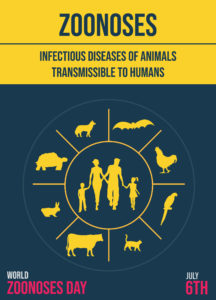One Health principles draw the connections between human, animal and environmental health. It wasn’t so long ago that the heroic work of a veterinary pathologist at a zoo connected the deaths of wild urban animals and zoo animals to the deaths of New York residents from the newly introduced West Nile Virus. Monitoring of animals and ecological systems remains inconsistent around the globe, including in the United States, despite these connections.
How We Got Here
In the United States, the only federal agency that tracks animal health is the US Department of Agriculture (USDA), whose primary task is to protect the health of crops and livestock. The USDA began in 1839 as a division of the Patent Office. Henry Leavitt Ellsworth, the Commissioner of Patents at the time, had an interest in new seed varieties and drove the creation of this division. In 1862, Abraham Lincoln made the organization its own department called the Department of Agriculture. In 1889, the Department of Agriculture was elevated to Cabinet level.
While the department does have a Wildlife Services program, its work is intended to react to needs as they arise, so it does not monitor wildlife or ecological systems that affect human exposure to disease-transmitting vectors, like ticks, with the same intensity as it monitors livestock. The current Wildlife Services was called Wildlife Damage Control until 1997, indicating its focus. Its funding is piecemeal, with state and local governments that request its assistance often responsible for the associated expenses. No agency monitors the health of companion animal populations, such as dogs, cats, or horses, at a national or state level. This information should be readily available for communities because the bacteria, viruses, and parasites that our pets contract can often be transmitted to people.
Filling in the Gaps
At the US Centers for Disease Control (US CDC), the National Center for Emerging and Zoonotic Infectious Diseases (NCEZID) was established in 2010. NCEZID’s budget for 2020 is $509 million. The US Department of Defense established a program for Global Emerging Infections Surveillance (GEIS) in 1997. Both organizations have both domestic and global focuses. However, their impacts are relatively modest.
USAID helps nations around the world with zoonotic monitoring. For 10 years ending in 2019, USAID ran a program called PREDICT that searched for emerging zoonotic disease. Research like this found a close cousin to SARS-CoV-2 before it emerged as a global pandemic.

Somewhat less than half of state and local health departments do surveillance of ticks at least through evaluating ticks that are brought to them, and a small percentage of them have budgets for tick control measures. Active tick surveillance or ecosystem surveillance that includes evaluating small mammals for zoonotic diseases spread by ticks is less common.
Private and non-governmental organizations also fill in gaps. Some pet surveillance in the US is done through a CDC partnership with veterinary colleges. The Companion Animal Parasite Council (CAPC) has started a program called Pet Disease Alerts to communicate disease surveillance information to veterinarians and the public. CAPC currently monitors for leptospirosis and canine influenza outbreaks in dogs.
The CDC also offers resources such as their toolkit addressing companion animals with SARS-CoV-2. These resources provide information to help people and companion animals to live together healthily.
Conclusion
In 2012, the CDC published an article discussing the risks that exist without surveillance of pets for zoonotic disease. Galaxy Diagnostics co-founder Dr. Breitschwerdt was one of the co-authors of that article. This year, ehrlichiosis was introduced to northern Australia and has spread rapidly. Though there was a program to test for ehrlichiosis, the dog that introduced the bacteria tested negative on its travel screening. And of course we are in the midst of a worldwide social and economic disaster created by the zoonotic virus SARS-CoV-2. All of this points to the need for more proactive monitoring that protects human and animal health.
Monitoring that only focuses on animals with economic importance in agriculture is not enough. It is clear that our health as individuals as well as the health of our communities and nations is connected to the health of wildlife and pets. How we got here isn’t enough to get us where we need to go.
References
Quammen, D. (2020, May 4). Why weren’t we ready for the coronavirus? The New Yorker. Available at: https://www.newyorker.com/magazine/2020/05/11/why-werent-we-ready-for-the-coronavirus
HealthDay News. (2020, June 18). Tick control across U.S. lagging amid rising Lyme disease threat. UPI.com. Available at: https://reachmd.com/news/tick-control-across-us-lagging-amid-rising-lyme-disease-threat/1637985/
Daly, J., & Fowler, C. (2020, July 9). Flawed testing of imported pets could be behind potentially deadly dog disease outbreak. ABC Rural. Available at: https://www.abc.net.au/news/rural/2020-07-10/botched-testing-imported-pets-deadly-dog-disease-outbreak/12439812
Boudreau, E. (2020). New “pet disease alerts” meets critical need to alert veterinarians, pet owners about infectious disease outbreaks threatening health of pets and people. PRWeb. Available at: https://www.prweb.com/releases/new_pet_disease_alerts_meets_critical_need_to_alert_veterinarians_pet_owners_about_infectious_disease_outbreaks_threatening_health_of_pets_and_people/prweb17202643.htm
Day, M. J. et al. (2012). Surveillance of zoonotic infectious disease transmitted by small companion animals [online report]. Emerging Infectious Diseases, 18(12). 10.3201/eid1812.120664 https://wwwnc.cdc.gov/eid/article/18/12/12-0664_article


